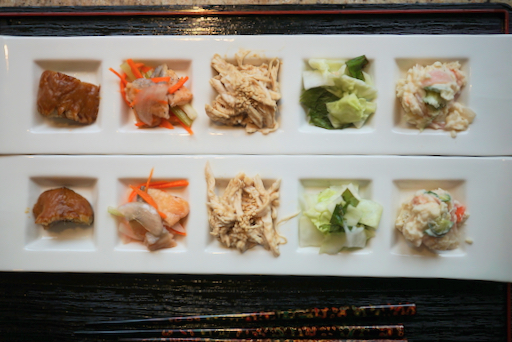Ingredients: (about makes 8 small servings like seen in picture #1).
2 Japanese (Asian) eggplants (picture #2), each weighed about 110-115 grams, stem ends removed and cut into a large bite size by cutting on bias as you roll 45 degrees (“ran-giri” 乱切り)
2 fresh shiitake, large and thick, stems removed and cut into a similar size large chunks
1/2 tsp ginger root, peeled, and julienned,
5-7 perilla leaves, finely chopped
1 tbs vegetable oil (I used peanut oil) with a splash or dark sesame oil
Seasonings:
1 tbs oyster sauce
1/2 tbs soy sauce (I used x4 Japanese noodle sauce)
1/2 tsp sugar (optional)
1 tbs Shiaoxing wine (optional)
1/3 cup chicken broth, low sodium
2 Japanese (Asian) eggplants (picture #2), each weighed about 110-115 grams, stem ends removed and cut into a large bite size by cutting on bias as you roll 45 degrees (“ran-giri” 乱切り)
2 fresh shiitake, large and thick, stems removed and cut into a similar size large chunks
1/2 tsp ginger root, peeled, and julienned,
5-7 perilla leaves, finely chopped
1 tbs vegetable oil (I used peanut oil) with a splash or dark sesame oil
Seasonings:
1 tbs oyster sauce
1/2 tbs soy sauce (I used x4 Japanese noodle sauce)
1/2 tsp sugar (optional)
1 tbs Shiaoxing wine (optional)
1/3 cup chicken broth, low sodium
Directions:
In a wok, add the oil on medium high flame. When the oil is shimmering add the eggplants. Starting from the skin side cook/brown for several minutes turning as needed.
Add the shiitake and cook 2-3 minutes more.
Add the ginger and stir.
Add the wine and broth (careful it may ignite).
When the liquid starts boiling, turn down the flame to medium and add the oyster sauce, soy sauce and sugar.
Reduce the liquid a bit and add the perilla.
Check the seasoning and adjust
The combination of eggplant and shiitake work every well together with nice umami reminiscent of a meat dish. The addition of the perilla adds a nice bright taste which provides a good contrast.
In a wok, add the oil on medium high flame. When the oil is shimmering add the eggplants. Starting from the skin side cook/brown for several minutes turning as needed.
Add the shiitake and cook 2-3 minutes more.
Add the ginger and stir.
Add the wine and broth (careful it may ignite).
When the liquid starts boiling, turn down the flame to medium and add the oyster sauce, soy sauce and sugar.
Reduce the liquid a bit and add the perilla.
Check the seasoning and adjust
The combination of eggplant and shiitake work every well together with nice umami reminiscent of a meat dish. The addition of the perilla adds a nice bright taste which provides a good contrast.




















